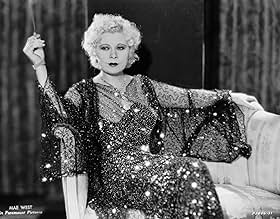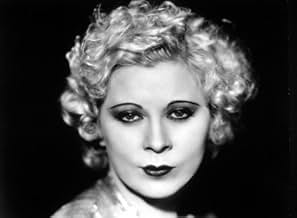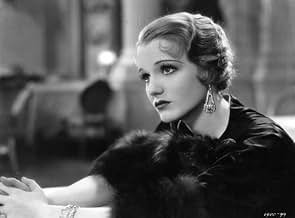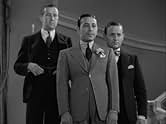PUNTUACIÓN EN IMDb
6,7/10
1,2 mil
TU PUNTUACIÓN
Añade un argumento en tu idiomaA successful ex-boxer opens a high-class speakeasy in what once was the childhood home of a formerly rich society girl.A successful ex-boxer opens a high-class speakeasy in what once was the childhood home of a formerly rich society girl.A successful ex-boxer opens a high-class speakeasy in what once was the childhood home of a formerly rich society girl.
George Templeton
- Patsy
- (as Dink Templeton)
Jay Eaton
- Nightclub Patron
- (sin acreditar)
Bill Elliott
- Escort
- (sin acreditar)
Patricia Farley
- Hatcheck Girl
- (sin acreditar)
Dick Gordon
- Nightclub Patron
- (sin acreditar)
Theresa Harris
- Ladies' Room Attendant
- (sin acreditar)
Argumento
¿Sabías que...?
- CuriosidadesIn the famous scene in which the hat-check girl exclaims over Maudie's (Mae West) jewels, "Goodness, what beautiful diamonds," and Maudie replies, "Goodness had nothing to do with it, Dearie", the diamonds were real and belonged to West.
- PifiasA tipsy Mabel Jellyman takes her hand off a champagne bottle twice after setting it on the table.
- Citas
Hatcheck girl: Goodness, what beautiful diamonds!
Maudie: Goodness had nothing to do with it, dearie.
- ConexionesFeatured in Hollywood: The Gift of Laughter (1982)
- Banda sonoraEveryone Says I Love You
(uncredited)
Music by Bert Kalmar
Played at the speakeasy when Joe makes the rounds and first spots Jerry
Also played at the end
Reseña destacada
While I enjoyed “The Mae West Glamour Collection” more than I expected to, I decided to leave her debut film for last, knowing that it wouldn’t be a typical vehicle of hers since she wasn’t the lead; I also figured it would be, as Leonard Maltin bluntly puts it, “a crashing bore”. However, I was quite surprised by how engaging and entertaining it all was – if, by no means, a classic. The film, in fact, is an agreeable blend of two styles that were en vogue during the early Talkie era: the sophisticated comedy-drama and the gangster picture, apart from also being adapted from a stage play (as were a good many movies back then).
The lead proper of the film is George Raft, who had just shot to stardom following his memorable supporting role in Howard Hawks’ SCARFACE (1932); of the stars associated with the heyday of the Gangster movie, Raft always seemed to me the most limited in range – but he does well enough here, flanked by his butler-cum-henchman Roscoe Karns (a mainstay of 1930s comedies). Watching this flick 75 years after it was made, I couldn’t help but wonder about all the gay subtexts today’s audiences would erroneously interpret in their “relationship” here!
Raft is the owner of a speakeasy who wants to improve himself for the sake of ‘mysterious’ socialite Constance Cummings (who, as it turns out, used to own the building) – despite being involved with at least two other women of lower standards (Wynne Gibson and Mae West); to do so, he engages the services of elderly teacher Alison Skipworth. Cummings (who’s adorable throughout – as had also been that same year in Harold Lloyd’s MOVIE CRAZY) incurs the wrath of jealous Gibson, who confronts her and Raft with a gun – a situation which Cummings finds exciting, drawing her nearer to Raft than she intended and deluding him into thinking that she has affections for him; of course, when he finds out that she had counted on marrying wealthy Louis Calhern all along, he gives up his cultured airs and withdraws his promise of selling the club to a rival! But during the ensuing mob fracas at Raft’s joint, Cummings realizes that she loves him after all...
As I said, I found the film to be fairly interesting for several reasons: Mae West’s own role isn’t central to the main plot (in fact, she not only appears exactly at the midway point of the film but shares more scenes – and even a bed! – with Skipworth than she does with Raft himself), but her presence certainly boosts proceedings; already, she’s got her way with dialogue (and not just the famous “Goodness had nothing to do with it, dearie” line) but it also feels like she’s playing a real character in this case rather than just being her in-your-face ‘naughty’ self…and West’s figure is perhaps at its sexiest here with as racy a costume as Pre-Code Hollywood liberalism ever got!
It’s amusing to watch the accompanying trailer today – hyping Raft’s rising star power (even mentioning a couple of earlier films apart from SCARFACE, both of which are now completely forgotten), and how this was achieved largely through the clamor of the movie-going public, when NIGHT AFTER NIGHT’s greatest (single?) claim to fame nowadays is for having introduced Mae West to the silver screen!
Finally, I wonder whether Universal is planning to release a second set of her films (they own four of her remaining titles); THE HEAT’S ON (1943) is a Columbia picture but it has already been released by Universal on R2 as part of a 6-Disc Mae West Set which also includes the bulk of the as-yet-unavailable titles on R1 (plus a couple of overlaps)!
The lead proper of the film is George Raft, who had just shot to stardom following his memorable supporting role in Howard Hawks’ SCARFACE (1932); of the stars associated with the heyday of the Gangster movie, Raft always seemed to me the most limited in range – but he does well enough here, flanked by his butler-cum-henchman Roscoe Karns (a mainstay of 1930s comedies). Watching this flick 75 years after it was made, I couldn’t help but wonder about all the gay subtexts today’s audiences would erroneously interpret in their “relationship” here!
Raft is the owner of a speakeasy who wants to improve himself for the sake of ‘mysterious’ socialite Constance Cummings (who, as it turns out, used to own the building) – despite being involved with at least two other women of lower standards (Wynne Gibson and Mae West); to do so, he engages the services of elderly teacher Alison Skipworth. Cummings (who’s adorable throughout – as had also been that same year in Harold Lloyd’s MOVIE CRAZY) incurs the wrath of jealous Gibson, who confronts her and Raft with a gun – a situation which Cummings finds exciting, drawing her nearer to Raft than she intended and deluding him into thinking that she has affections for him; of course, when he finds out that she had counted on marrying wealthy Louis Calhern all along, he gives up his cultured airs and withdraws his promise of selling the club to a rival! But during the ensuing mob fracas at Raft’s joint, Cummings realizes that she loves him after all...
As I said, I found the film to be fairly interesting for several reasons: Mae West’s own role isn’t central to the main plot (in fact, she not only appears exactly at the midway point of the film but shares more scenes – and even a bed! – with Skipworth than she does with Raft himself), but her presence certainly boosts proceedings; already, she’s got her way with dialogue (and not just the famous “Goodness had nothing to do with it, dearie” line) but it also feels like she’s playing a real character in this case rather than just being her in-your-face ‘naughty’ self…and West’s figure is perhaps at its sexiest here with as racy a costume as Pre-Code Hollywood liberalism ever got!
It’s amusing to watch the accompanying trailer today – hyping Raft’s rising star power (even mentioning a couple of earlier films apart from SCARFACE, both of which are now completely forgotten), and how this was achieved largely through the clamor of the movie-going public, when NIGHT AFTER NIGHT’s greatest (single?) claim to fame nowadays is for having introduced Mae West to the silver screen!
Finally, I wonder whether Universal is planning to release a second set of her films (they own four of her remaining titles); THE HEAT’S ON (1943) is a Columbia picture but it has already been released by Universal on R2 as part of a 6-Disc Mae West Set which also includes the bulk of the as-yet-unavailable titles on R1 (plus a couple of overlaps)!
- Bunuel1976
- 23 nov 2007
- Enlace permanente
Selecciones populares
Inicia sesión para calificar y añadir a tu lista para recibir recomendaciones personalizadas
- How long is Night After Night?Con tecnología de Alexa
Detalles
- Fecha de lanzamiento
- País de origen
- Idioma
- Títulos en diferentes países
- Night After Night
- Localizaciones del rodaje
- Empresa productora
- Ver más compañías en los créditos en IMDbPro
- Duración1 hora 13 minutos
- Color
- Relación de aspecto
- 1.37 : 1
Contribuir a esta página
Sugerir un cambio o añadir el contenido que falta

Principal laguna de datos
By what name was Noche tras noche (1932) officially released in India in English?
Responde






















